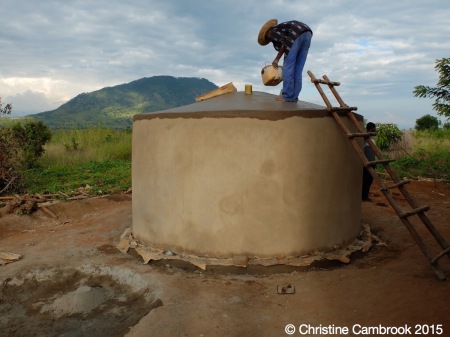We were super lucky to have the brilliant Christine in Milange for over a month when she took time off from her job as a sustainability engineer to work with Joanne on the construction of 2 rainwater harvesting tanks in the district of Milange. She’s written a brilliantly simple blog about the need for the tanks, a bit about how they were built and some of the community development aspects. Special shout out to her for surviving long periods in the villages living in tents, eating only local food and being able to only communicate through Joanne!
Hello!
I’m Christine, Joanne and Andrew have asked me to write a guest blog, as I’ve just spent 4 weeks supporting Joanne and her team on the construction of two rainwater harvesting tanks, in Mambucha and Njema communities.
Rain water harvesting is a great idea in areas with no mains water supply, and as regular readers will know, the area where Joanne is working experiences very heavy seasonal rainfall. The average annual rainfall in Milange is over 1,700mm – which for comparison, is nearly 3 times what we receive in London. And that mainly happens over a 3-4 month period. So if you think it rains a lot in London, you are sorely mistaken. Rainwater harvesting is essentially building a massive storage tank so you can keep that water clean and accessible through the dry season.
The limiting factor in ability to use rainwater harvesting in rural Mozambique is actually the availability of appropriate roofs – the majority of buildings have grass roofs, it’s only the most recent or expensive buildings that have corrugated roofs. Hence the buildings selected for rainwater collection were a church and a school. We carefully sized the first water tank based on the available roof area and rainfall data, and then made the executive decision to stick exactly to the design the team had already built once, to minimse potential for error – either in materials quantities or construction. The design we built could provide water through the whole of the dry season, if water usage is limited to 6 buckets per day. However, it’s up to the community to decide how and when they use the water, and who gets priority. In reality most community members will have to go back to their alternative water source (generally walking a long way to a river) during the end of the dry season, but hopefully the tanks will still make people’s lives easier and healthier for the majority of the year.

Joanne and I whiled away a fair bit of time considering the parallels between baking a cake and mixing cement, but I’m not sure they were particularly insightful or funny so I’ll just share a photo of cement mixing.
As anyone with a smidgen of management experience knows, the hardest thing about most jobs is getting a good team. Luckily (and by luck I mean due to years of hard work by the Diocese) Joanne has an excellent core team in Patricio and Pedro, and lots of construction experience within the team. Mozambiqian men are generally experienced in construction, all having built their own houses.

Our very organised materials store, and a non-compliant with UK health and safety law manual handling method!

The wire reinforcment for the tank walls – Patricio is adding water to the floor to help the concrete base of the tank cure properly, increasing its strength
One of the core ideas that Joanne and the team were keen to see implemented was that the community who are benefiting from the rainwater tank should support in the construction process. This was generally well carried out (despite some teething problems), with the women in each community doing a sterling job of collecting the large amounts of water required for cement mixing and also cooking the construction teams 3 meals a day – it’s no mean feat to cook for a team of between 8 and 18 three times a day on an open fire. The men provided labour for construction and did a great job.

The roof is supported by a system of wooden beams that are then covered in sacking and several layers of wire before being cemented over

One of the last things to do is to add gutters to the building roofs, and connect them to the rainwater tank. The tank is also painted with a lime and cement mixture to help with the impermeability
Now all that’s left to do is to wait for the rains!*
*Poetic license, actually there are various things left to do such as removing the internal timber supporting structure in both tanks, attaching the gutters in Njema, and putting on the taps. Still need to wait for the rains though.





Good job guys!
It’s so wonderful for a novice like me to see the process step by step. What a wonderful sense of accomplishment there must be when it’s is completed. So glad to see everyone working together.
How do you get the internal timber out of the completed tank?
There’s an entrance hatch which people will use to also go in and clean the tank. There’s even a built in internal ladder. Hopefully all of the internal timber is small enough to fit out the hatch!